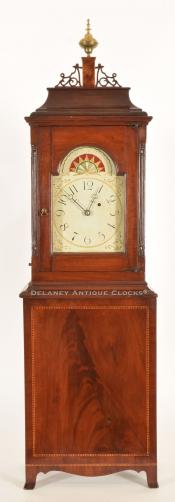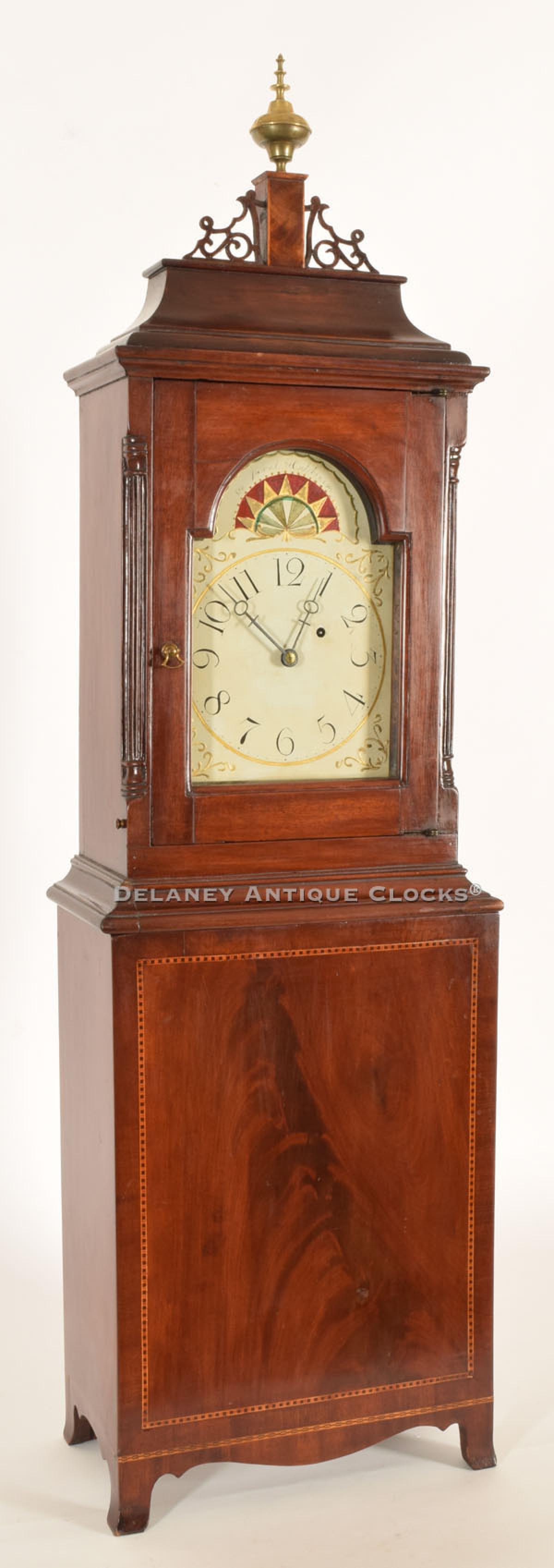Joshua Wilder of Hingham, Massachusetts. Dr. Samuel Hutchinson's inlaid mahogany shelf clock. YY-43.
This attractive Massachusetts case shelf clock has works by the important Southeastern Massachusetts clockmaker Joshua Wilder [1786-1860].
The clock case is constructed figured mahogany and features high-quality veneers. The finish is lovely and rich in color. This case stands on four flared French feet. The interior line of the front feet transitions into a shaped apron that hangs from the case. A complex line inlay visually separates the feet and the base. The center of the base panel features a beautiful selection of vertically-formatted crotch veneer. It is framed with a line inlay pattern composed of an alternating box pattern of light and dark woods. A nicely shaped molding transitions the base section to the bonnet or hood. The front corners of the hood are fitted with finely reeded quarter columns that terminate in turned wooden capitals. These also visually support the upper section of the bonnet. The upper molding is somewhat reserved. Above this is a sarcophagus or bell top, fitted with a delicate pierced and open fret-work design mounted to a single finial plinth. The plinth is veneered on the front with a figured grain pattern. Light wood line inlay trims the front edges. The plinth is capped at the top and fitted with a brass finial. The hood door is constructed like those found on the dwarf clock. The opening is an arch shape that is fitted with glass.
This iron dial was paint-decorated by Spencer Nolen, a well-known Boston ornamental artist. The four spandrel areas are decorated with raised gesso patterns, highlighted with gilt paint. A colorful radiant is located in the arch of this dial. The colors are excellent, and the red stands out brilliantly. Incorporated into this design is the wording "Dr. Samuel Hutchinson." We speculate that he was the original purchaser of this clock. A gilt ring frames the time ring. The hours are in Arabic form. Please note the wonderfully shaped steel hands. Around the center arbor is evidence of the Maker's signature. It is now somewhat faint, but in the right light, it reads, "J. Wilder / HINGHAM."
The movement or works are constructed in brass and are of good quality. Four-turned and shaped pillars support the two brass rectangular-shaped plates. Hardened steel shafts support the polished steel pinions and brass gearing. The escapement is designed in a recoil format. The winding drum is turned smooth and can hold eight days worth of weight cord. The timepiece movement is weight-driven and designed to run for eight days on a full wind. It is not designed to strike.
This clock is approximately 42.5 inches tall to the top of the finial. It is 12.25 inches wide and only 6.75 inches deep.
Inventory number YY-43.
Joshua Wilder was born in Hingham, Massachusetts, on December 2, 1786. He was trained in the art of clockmaking by John Bailey Jr. of Hanover, MA. Wilder completed this apprenticeship sometime around 1807. It appears he stayed in Hanover briefly before moving back to Hingham to establish his home and business on Main Street in the South Parish. Wilder was the first clockmaker to settle in this prosperous town. He found a ready market for tall case clocks, dwarf clocks, wall timepieces, the Massachusetts shelf form, and mirror clocks. Wilder becomes one of America’s most prolific Makers of the dwarf clock form.
Joshua Wilder was active in the local religious Society of Friends. He became known locally as the “Old Quaker Joshua Wilder.” He was also involved with the Temperance Society and Peace Society of Hingham. Wilder’s business eventually evolves into a retailer of common goods. Wilder is said to have trained several Clockmakers, including his son Ezra Wilder, Reuben Tower, Allen Kelley, and Phillip Bennet. About 1840, it is said that his son Ezra joined him in business. Joshua died on October 4, 1860, in the town of Scituate.
A fair number of clocks made by this maker have been found. Many of these are the dwarf form but also include tall case clocks, timepieces, shelf clocks, and mirror clocks in much smaller numbers. Currently, the Hingham Library is displaying a tall case clock he made.










